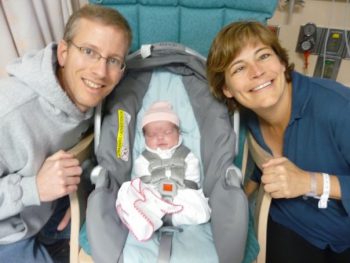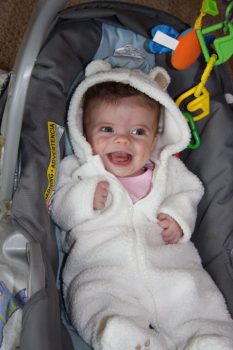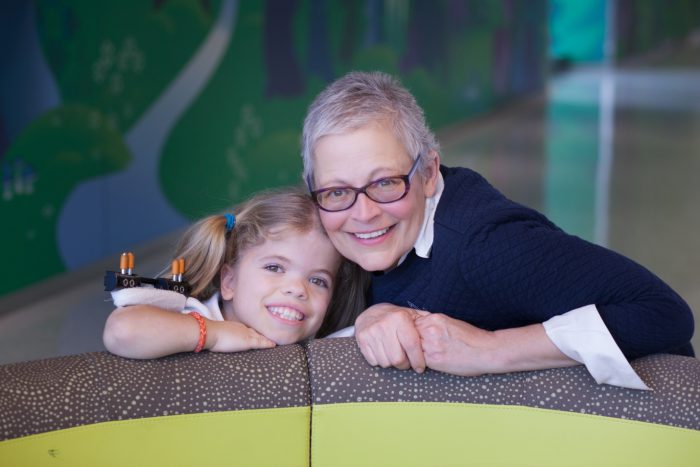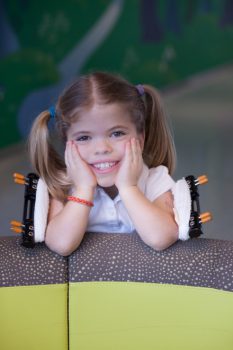
Lisa Booth was 40 weeks and 6 days into what had been a completely normal pregnancy when she received unexpected news during an ultrasound.
“Everything was fine at 9 a.m. At noon, I was told my daughter would be a dwarf. By 4 p.m., I was told she wasn’t going to survive,” said Booth. “I went home in a completely shell-shocked state.”
Hours later, Booth went into labor expecting the worst.
“Going into labor I was thinking she wouldn’t survive,” she said.
But when her daughter, Anna, arrived that night, she came out pink and crying.
“You would never have known something was wrong,” said Booth. “Anna is short and that’s it.”
Anna was diagnosed with dwarfism, but not a fatal form as the doctors expected. The news was a relief, but Booth understood firsthand the challenges her daughter would face. Booth was born with a congenital birth defect that affected her eyes. She knows the social challenges that can come with appearing a little different than other people.
“People always stared at me,” said Booth. “I had a noticeable physical disability. I know there are going to be people who stare at Anna. She can’t control that people will notice her, but she can control how she reacts to it.”
Today, Booth and Anna live by a simple, optimistic motto: “You’ve got to find the bright side in every part of your life.”
It’s that motto that helped carry them through some very trying times.
Finding a home at Seattle Children’s

Anna’s first appointment at Seattle Children’s was when she was 1 month old. She was diagnosed with achondroplasia, a rare genetic bone disorder. Achondroplasia is the most common type of dwarfism, in which a child’s arms and legs are short in proportion to their body length.
According to Dr. Maryse Bouchard, an orthopedic surgeon at Seattle Children’s, children like Anna need to be followed closely by a care team who specialize in children with dwarfism and skeletal dysplasias. Seattle Children’s Skeletal Health Program brings together surgeons, endocrinologists, geneticists, neurosurgeons, pulmonologists, radiologists and nurse practitioners to help diagnose and treat children with skeletal conditions from infancy through adulthood.
“We monitor children with achondroplasia closely through infancy. We tend to see these kiddos every three months until they are 2 years old,” said Bouchard. “As children grow up, it’s important to have a team that not only understands a child’s medical needs, but their social needs as well.”
Seattle Children’s became of staple of Anna’s childhood. The family visited the hospital often for appointments, and their care team quickly became like family. She was seen by a myriad of specialists including sleep experts, pulmonologists and nutritionists.
“It’s been a blessing to have Seattle Children’s as a part of our journey,” said Booth.
Unexpected news
In April 2015, Booth was blindsided with a medical challenge of her own. She was diagnosed with stage 4 breast cancer. Together, she and Anna were on two different medical journeys.
Booth didn’t want her daughter to be reliant on other people for everyday tasks. She envisioned a life of independence for her daughter.
Sometimes, arms of children with dwarfism and skeletal dysplasia are so short it’s difficult to manage daily activities. In these cases, limb lengthening surgery is considered. For Anna, this was the case. They began conversations with Bouchard, about limb-lengthening options. According to Bouchard, it’s not a conversation that’s taken lightly.
 “It’s not for everyone and every family,” said Bouchard. “We decide together. There are a lot more risks than the average surgery. It also has a social and emotional component. The surgery itself is only a small piece of the procedure.”
“It’s not for everyone and every family,” said Bouchard. “We decide together. There are a lot more risks than the average surgery. It also has a social and emotional component. The surgery itself is only a small piece of the procedure.”

During the limb lengthening surgery, a surgeon cuts the child’s bone and attaches a distractor device, which in Anna’s case was outside the body. The device slowly lengthens the limb at the area where the bone was surgically cut and new bone forms in between. This lengthens the limb gradually.
Together, with Bouchard, her family decided to move forward with the limb lengthening surgery, but there was something else they had to face. Booth’s battle with cancer had its ups and downs.
Nearly 10 months after her initial diagnosis she was in remission, but the cancer came back. Booth and Bouchard needed to decide which surgery would come first, a surgery for her or Anna.
“Seattle Children’s didn’t just treat Anna, they treated our whole family,” said Booth. “I knew if we ever needed anything, they’d be there. Everyone was incredibly supportive. We were in good hands.”
In September 2017, Booth was again in remission and the timing seemed right for the limb lengthening procedure. They scheduled the limb lengthening surgery for Anna.
“Anna loves Dr. Bouchard,” said Booth. “We trusted her. When we’d have appointments at Seattle Children’s Anna would ask me, ‘Are we going to see the doctor with Elsa hair?’ Our experience through everything has been exceptional. Seattle Children’s is more than just a hospital.”
A step towards independence
The surgery was a success. The devices on Anna’s arms took a little getting used to, but they soon became part of her wardrobe. Finding outfits wasn’t easy at first either. The braces don’t work well with typical garments, and so they found a fashionable way around the problem. Anna’s clothing was adapted with a trend her mom calls “cold shoulders.” With cut-outs at the shoulder, they easily accommodated for the devices that run from the top of her shoulders down her arm.
“It’s her own little fashion statement,” said Booth.
New bone, new independence

After two months wearing the distractor devices, Anna’s upper arms doubled in size, more than six centimeters in both arms.
“During the distraction phase her bone grew nearly 1 millimeter a day,” said Bouchard. “After 75 days, we lengthened her arms by six and a half centimeters.”
Yesterday was a big day for Anna, she got the devices removed. The lengthening process is finished, and the charismatic 8-year-old is thrilled to be able to enjoy her new found sense of independence.
What’s first on her agenda? Hitting the slopes! Anna loves to ski, and with the distractors off, she will easily fit into her ski jacket.
Overcoming adversity
Anna and her mother have been through a lot, but they’ve found happiness and humor through adversity. Their advice to other people is one of strength and optimism.
“You don’t know what your journey is going to be until you’re on it, but you’ve been given the strength to handle it,” said Booth.
When asked about everything their family has endured, Booth replied with a message of resilience.
“It is what it is,” she said. “We’ve made it through.”
Resources:
- Dwarfism and Skeletal Dysplasias

